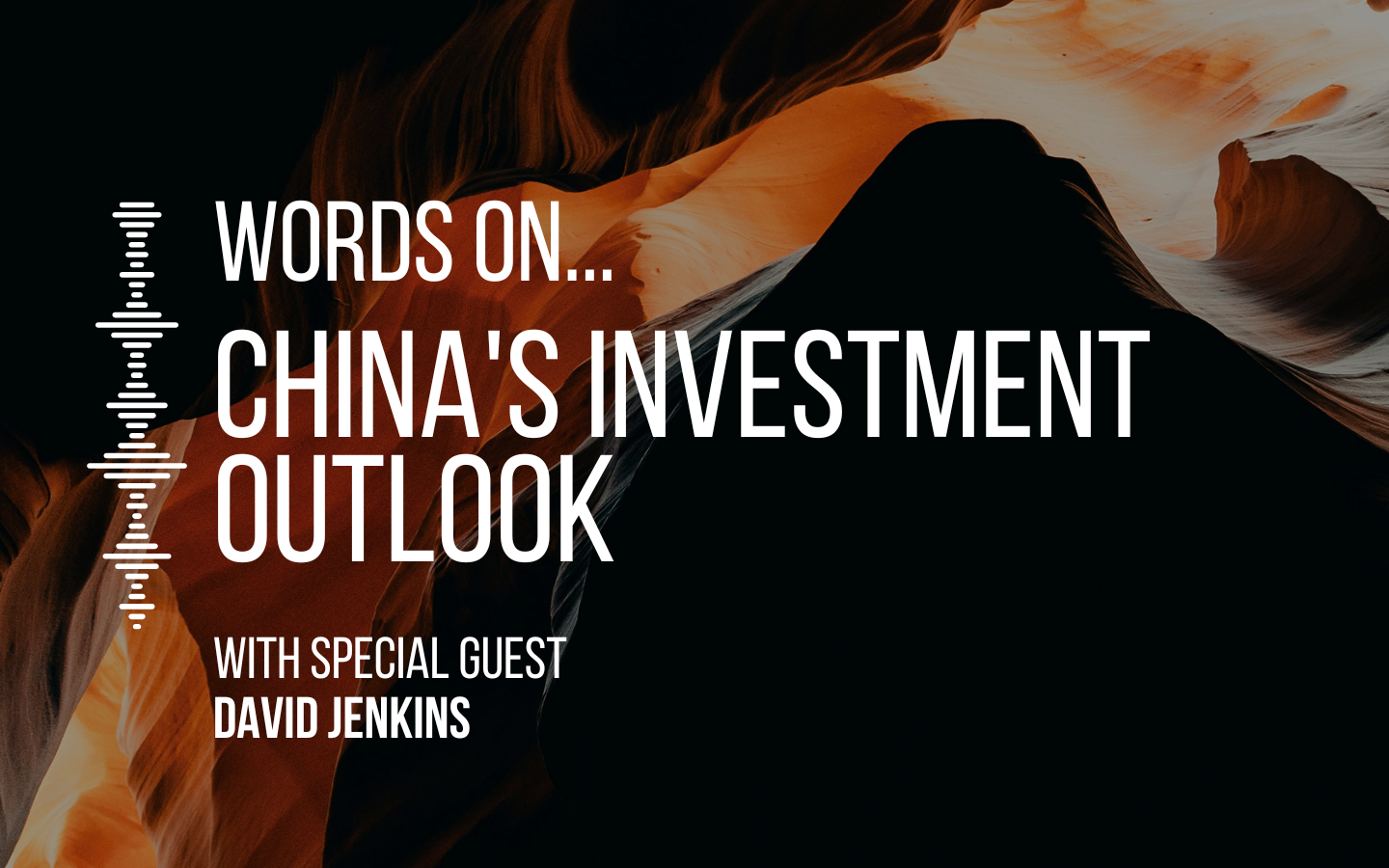


In this episode of Words on Wealth, Evans and Partners CIO, Tim Rocks is joined by Loftus Peak’s CIO, Alex Pollak and Head of Research, Raymond Tong, for a dynamic conversation on the rapidly evolving world of AI. They explore the rise of agentic AI, and the mounting energy demands being driven by increased AI innovation across the globe. The trio also examine the competitive landscape between the U.S. and China, the disruption of traditional search, and how Loftus Peak is positioning its portfolio to capture opportunities across the AI value chain. Tune in to find out more.
This episode is also available on Apple Podcast.
Tim Rocks
Hello and welcome to Words on Wealth. I’m Tim Rocks, Chief Investment Officer. Today I’m delighted to explore the world of AI again with our really business partners, Loftus Peak. With us today, I have Alex Pollock, who’s the CIO of Loftus Peak and Raymond Tong, who is Head of Research. Welcome gentlemen and thanks for your time.
Alex Pollock
Thanks Tim, thanks for having us.
Raymond Tong
Thanks for having us.
Tim Rocks
Look, mean, AI is, you we’re returning to one of the most exciting trades, topics, themes out there. We did speak with these gentlemen last year. Even more has happened at probably at a faster rate since that last discussion. So it’s great to get into some of the recent developments. So why don’t I start with you, Ray. Can you start by discussing some of those recent developments and what’s going on in the last six to 12 months?
Raymond Tong
Yeah, short term and I think as you said, mean, things have changed and moved so quickly even ⁓ in the last few months. But I think generally over the past six to 12 months, think ⁓ AI has rapidly evolved from I simple content generation to much more advanced reasoning and decision making. ⁓ Now models now can handle sort of complex multi-step tasks, ⁓ which is really paving the way for sort of what they call agentic AI, where their systems can plan, reason and act. A year ago, agents barely existed and now they’re one of the hottest things that people are talking about in AI. I think an example of this, probably one that people can relate to is deep research in chat GPT. So that’s a sort of relatively new feature that came out which you can act like your own analyst in a way. So you can ask it to scan websites, documents on a particular topic, conduct analysis, summarize findings, and really generate insights for you. We’re also seeing some new challenges emerge as well. So obviously most people probably would have heard about DeepSeek in China earlier this year. They built or they are building competitive models at a lower cost, which I think is also broadening innovation globally so that a lot of the US models need to adopt some of the techniques that they’ve used. I think at the same time, in terms of the models, I think last year we mentioned how they were becoming multimodal. These are maturing quite quickly now. So you’re seeing things like text to video, text to images, know, text to voice, becoming a lot more mainstream. Earlier this year, OpenAI had a new image generation tool that went viral earlier this year. And then what we’re seeing at the moment is that adoption is exploding at the moment. So ChatGPT has grown to 800 million weekly active users. I think that was about a couple of months ago. And that’s up from about 400 million just earlier this year. So it’s nearly doubled within a few months. Google recently said at one of its developer conferences that the amount of tokens processed across its models was 480 trillion in a month. And this is just a proxy for the usage of its models. And that’s a 50X jump from a year ago. And there was a major inflection point in March and April. And I think some of that is driven by some of those reasoning models that we talked about before. And all of this is driving sort of massive infrastructure investment, not just by big tech, but also by another new place as well.
Tim Rocks
Great, mean that’s fascinating, it? So we’ll return and explore some of those issues ⁓ as we go forward. What about, let’s start on the infrastructure side, the last thing you mentioned there. ⁓ What are the latest developments there?
Raymond Tong
Yeah, I mean, I think in terms of the infrastructure build out, it’s accelerating faster than I think most people expect. And I think it has been sort of underestimated by the market. In the calendar year 2025, the hyperscalers, which are the big cloud providers like Microsoft, Amazon, Google, Oracle, Meta, they’re forecast by the market to spend over $300 billion in CapEx. I mean, not all into AI infrastructure, but there’s just an aggregate amount. And that’s up by around about 40 to 50 % from last year. And that is the increases mainly driven by AI infrastructure. And at this stage, demand continues to outstrip supply by a fair bit. It’s not just big tech. think you’re seeing venture capital funding pour in. So OpenAI ⁓ in March, April, they raised $40 billion, which is a record amount for a VC deal. And then XAI, which is the Elon Musk’s AI company, they raised 20 billion as well, which was the second biggest funding round on record. And so you’re seeing heaps of VC money come in. And then at the same time, we’re seeing lots of sovereign capital come in from the Middle East. think we probably heard some of the deals that ⁓ the US and Trump signed with some of the Middle East and countries and that’s pretty much to building their own AI infrastructure. And then I think at the same time you’re seeing a lot of these GPU clusters or things being built into the data centers, they’re becoming something like gigawatt scale now, up from sort of hundreds of megawatts. And that’s to meet all the training and inference demands out there. So you’re seeing that happen. And Nvidia is still the key beneficiary from this, but I think you are seeing a bit of it broadening out. A lot of the hyperscale companies are designing their own custom chips to try to rely less on Nvidia and lower their costs. And a company like Broadcom is a beneficiary of this. And then probably finally, maybe before I hand over to Alex as well, there’s also sort of an energy challenge as well. ⁓ it’s all pretty energy and power intensive and ⁓ some of these facilities use as much electricity as a small city. And so there is a sort of a big scramble for power at the moment. And then you’re also seeing an increasing number of deals ⁓ with nuclear ⁓ power generation as well. And in many ways, power is probably becoming the next major bottleneck in the scaling of AI.
Tim Rocks
Yeah, I guess that raises the first question about how profitable that investment in infrastructure is from here, whether there’s too much capital around and perhaps whether that’s the right way to play this theme from here.
Alex Pollock
I’ll take a bit of this. we have visibility on the level of CapEx, but obviously we don’t have visibility on the growth in revenue. And as it looks out from here, ⁓ the return on investment, the return on capital is decreasing unless they hit new revenue targets, which they may or may not do. Obviously, in the first instance, the sweetest returns come from the earliest deployment of the tools that become the most important tools. So that explains, if you like, why we pulled out of Nvidia and some of the AI stocks towards the end of last year. But it also explains why we re-entered them quite heavily again in the last few months, because the data points ⁓ in terms of revenue were better than we had expected and we had more visibility on them. And we’ve been paid for that ⁓ analysis in the rising prices of Broadcom and ⁓ Nvidia and a bunch of others
Tim Rocks
Yeah. Yeah. And perhaps a question to you, Alex. Can you tell us about the implications for the search business that’s been a very large part of Google’s business, but could potentially be under threat from AI?
Alex Pollock
It’s an open question right now how Google will be paid, but that might generate a very significant ⁓ amount of ⁓ usage on the part of open AI into all of the Google data tools. And then how it’s built, well, you know, we’ll kind of see, but from the 10 blue links that Google provides, which is the monetization engine to date, you can see an AI monetization engine, which much more ⁓ holistically grabs all of the data that’s available and spits it out in a kind of, you know, useful manner. So ⁓ that’s happening, right? Just I’ll touch on this briefly, right, because we are at a point of significant uncertainty, think, in a whole bunch of ways, point of significant certainty to in other ways, but the uncertainty arises from the mechanism by which Google gets paid. And it also is whether the search that comes out of open AI, this thing that I just showed you is a better product and is used more than just Google search. In other words, Satya and Adele said at the very beginning of this, we’re using open AI to make Google come out and dance. And Tim and Evans and partners clients, I promise you, Google has come out to dance and they are absolutely doing a jig out there because they see that if they don’t respond and Gemini is their response, they see if they don’t respond that the open AI of Microsoft will take significant amounts of share from Google ⁓ as a search company. Now, it’s an open question, right, whether ultimately Google says, you’re trawling all my sites, so you have to pay us. That’s fine. But what I’d say is that the certainty of the mechanism has dropped somewhat. you know, OpenAI and ChatGPT and all the others that are raising truckloads of money see that search under Google is under threat. And they see that this is their opportunity to grab some of those search dollars from Google, which is creating both uncertainty and opportunity for us. And obviously, that’s the space in which we love to play. And we are playing, and that’s kind of working.
Tim Rocks
It’s true disruption, isn’t it?
Alex Pollock
Disruption, right? Because, know, for a long time, the question was who will disrupt the disruption? We’re always alive to that. And plainly, AI disrupts Google search. Plainly, it does. And it doesn’t say much that Google is fielding its own AI in the form of Gemini to create its own search. It’s no different to, if you like, you know, to use an example going back to my career 50 years, for 35 years ago. It’s no different to John Fairfax, the newspaper publisher, putting its content out on the web. They’re basically going, well, we’re going to lose it anyway. At least we’ll have some readers on our web if we do the print version and the ⁓ web version of our newspaper. This is the same. AI is disrupting Google, and Google’s response is we can sit here and just take it, or we can figure out our own version of AI and see how much market share we can have. But definitely it’s influx.
Tim Rocks
Yeah. Yeah. All right. Let’s return to some of the other upcoming trends, perhaps. ⁓ Roman, you mentioned the agentic AI as one of the new kind of trends. So looking out three to five years, perhaps that’s, you know, that’s, that’s our next phase. Are there are there other next phases? And what kind of transformations can we expect?
Raymond Tong
Yeah, look, I think, know, Nvidia CEO sort of describes it ⁓ quite nicely in a way that, you know, a year ago or two years ago, know, there’s sort of four major phases that he sees. So first one was perception AI. So that’s understanding languages, images, text, audio, then it’s genitive AI, which is ⁓ what we know now where you can create content. And then what we talked about before was just the agentic AI phase where systems, AI systems don’t just generate text, but they reason, they plan, ⁓ like what Alex just said. And then also take actions on the behalf of users as well. So that’s really, there’s been a lot of development on agentic software, lot of software companies are looking to implement that ⁓ this year and we’re probably going to see that more mainstream later this year and next year. ⁓ Probably the next phase, which is really interesting, this will probably lead into ⁓ what people call physical AI. So, you know, probably think about AI getting infused into the physical world. So think about things like robotics, ⁓ autonomous machines and vehicles which are all interacting with the physical world. it’s probably not that far away that and we’re already seeing signs of it like things like warehouse automation, autonomous vehicles. So Waymo, no Googles, driverless ride hailing services, a big AI project really. And what Tesla is doing with its full self-driving software is also an example of physical AI. And then probably the most interesting one potentially is also inter-robotic. So, one of the big things at the moment we were talking about and working on is humanoid robots. I think both Jensen Huang, the CEO of Nvidia and also Sundar Pichai from Google, they all recently said that… The chat GPT moment of robotics is just really around the corner. And when they say that, it’s probably the next year or two.
Tim Rocks
Yeah, yeah. And then as an extension of that, I mean, what are some real world use examples? So you just mentioned ⁓ the role that AI will play in autonomous vehicles, and taxis and the like. But ⁓ for now, what are the other kind of sectors companies that have really adopted it and used it to change their businesses?
Alex Pollock
I think that’s a better one for Ray.
Raymond Tong
Yeah, I mean, I think it’s interesting because I think this sort of follows on from the earlier question in a way that when we sort of talked about RII and at the moment, still pretty early, think that there’s a survey that Goldman Sachs did that suggests that around about 10 % of US firms had adopted AI, which sounds low, but… It’s very bear in mind that it’s growing very quickly, but also it takes a while to actually think about how to implement AI into a business. But at this point in time, I think some of the sectors where we’re seeing the highest adoption is in things like IT, professional services, education, finance, real estate and healthcare. And just to give some examples of this. In IT, some of the big tech companies like Microsoft, Google, and Meta, they’ve all said that AI tools are now assisting with around about up to 30 % of cogeneration now, which is driving a lot of productivity enhancements and has helped those companies actually keep their headcount relatively flat in the last year. In finance, think Jamie Dimon from JP Morgan said last week that they are spending around about two billion a year on AI. And they have around about 600 actual use cases at the moment. Now he expects the number of use cases will double or maybe even triple next year. That includes things like internal AI assistance, things to help with client interaction, core center support, risk management, including fraud detection and risk assessment. I think the Goldman Sachs CEO said just recently that AI, they just use AI now to draft 95 % of an IPO prospectors now in minutes and their tasks used to take a six person team two weeks. In other sectors, in healthcare, Nvidia has said that healthcare is actually one of the largest verticals. They recently signed a deal with ⁓ NovaNoidisc ⁓ to really accelerate the research and drug discovery process using AI models and also ⁓ agents. And then in education, you’re probably seeing a lot more personalized AI tutors emerge. Duolingo, the language tutor, they’ve really been quite aggressive in incorporating that into their business. And you can now practice talking to like an AI in a different language to get your skills up. And then probably I’ll just finish off. Finally, I think we’re seeing probably more companies take a really more aggressive AI first approach. And one of the ones this year which really stood out was Shopify. ⁓ So, effectively, it’s come straight from the founder and CEO down that ⁓ it’s ⁓ imperative that the whole firm just use AI first in most things. So they won’t approve new highs unless the role can’t be done by AI. And they have to prove it to the managers that AI can’t do it before they make the hire.
Tim Rocks
Wow. Yeah, I mean, in our business we’ve been trying look for every way that we can use it. And so far, it’s certainly there’s a lot of processy type stuff is preparing reports, preparing paperwork for the new funds and the like. And we’ve certainly seized this clear opportunities to make, make our job more efficient and make like make some junior jobs is more interesting, perhaps. So to get away from that real kind of mundane.
Alex Pollock
I mean, you can put a metric around it. think Ray’s got this great metric, which is the number of tokens and a token is just either a part of a word or a word or a number. And that’s the way you need to think about it. They make it sound harder than it is. A token is just part of a word or a number has increased 50 fold, I think in 18 months. And I can’t remember what the closing figure is, Ray. You might be able to help me. It was Microsoft’s use, wasn’t
Raymond Tong
Yeah, I think Microsoft said something, but also Google said, I think it’s 480 trillion tokens.
Alex Pollock
Yeah, and it’s a 50-fold increase right in 18 months. So, and that speaks to what you’re talking about, Tim. You you look around for ways that you can, I mean, we use it in here to extract the relevant points of stuff that we’ve had said, maybe in a podcast or in something that we’ve written so that we can hand it on to the sales team and the sales team can then leverage it without having to rewrite it themselves and et cetera, et cetera.
Tim Rocks
Yeah.
Alex Pollock
and they’re saving hours and hours out of every day, it makes them more productive. I see it every, I feel it everywhere, Call center time has dropped right off because so much of the query now is kind of appropriately placed to the appropriate person. And so much of it is kind of pre-cleared by, they know your phone number, they’ve got your policy up in front of you. You can see the effects really now starting to come through. And yeah, it’s, you know, people say, where’s the AI? And I say, well, you’re standing in it.
Tim Rocks
All right, now I don’t know who wants to take this one. China versus US, DeepSeek versus the US, I guess. Will China be a real competitor to the US in this field? And what are some of the implications of that?
Alex Pollock
Look, China will be a competitor in this field. I’ll just share this piece of data with you. One of the big consultancy firms, not someone allied with China, actually someone who I would call independent, rated the 14th five-year plan, which completes in 2025, as the best executed five-year plan by any government anywhere over time. Now, of course, There’s not much competition because a lot of them were very, very bad, especially the Soviet ones. But the one that Xi has done has, and you know, can love him or hate him. I’m not going to get into that. But the one that is concluded in China is actually, you know, pushed China to be, I won’t say ahead of America because they’re not ahead of America technologically, but they’re fast. They’re closing really, really fast. Even without, so to speak, the latest GPUs from Nvidia, ⁓ they have been able to achieve some massive gains in terms of ⁓ their fabrication capacity for chips. And you can see it there, you can see it in the battery technology, they’ve got better batteries now.
Tim Rocks
Well, electric vehicles has been a standard.
Alex Pollock
Electric vehicles has been a standout and I’ve got a friend that just come back from China and just said you can’t recognize it anymore. So they’re definitely coming ⁓ and we are all going to have to deal with China that probably is going to grow faster than the US off a lower base right now but it won’t take long. ⁓ And it’s especially difficult because Trump is alienating his allies. What is that saying? There’s only one thing worse than fighting with your allies and that’s fighting without them. He’s about to discover that he’s fighting without his allies, ⁓ irrespective of the tariffs, in a trade war, in a technology war, in a military war, in every kind of war there is. China is a big, big factor and the success of the last five years has really put them in a great position to overtake the US in the next five years.
Tim Rocks
Yeah, and the other part of that surely is the part of the battle here is an infrastructure battle. can build infrastructure? Well, ⁓ China can build infrastructure. US is? ⁓
Alex Pollock
Correct. China can build it because Xi says so and America, you know, it’s just with warring tribes.
Tim Rocks
Yeah.
Raymond Tong
I think it’s interesting that ⁓ the ban of NVIDIA GPUs into China has forced China to really innovate in a way. So you’ve seen it with the DeepSeq models where even though they probably did use NVIDIA GPUs to train it, it is a lower cost. And it’s also forced ⁓ Huawei, which is their sort of local chip champion to effectively, you know, they’re still behind Nvidia, but also accelerate the development of their own AI chips there as well. I ⁓ think what China has, I think to your point, ⁓ Tim, as well, is that they’ve got the ability to build infrastructure, but also they’ve got an abundance of power as well. And that’s really not a limitation for them. And so you’ve got more power. Effectively cobble together millions of GPU chips or even though they’re inferior to NVIDIAs and still get a reasonable outcome. ⁓ Whereas in the US, you might have the advantage in chips, but you do have a limiting side on the power side at the moment.
Tim Rocks
Yeah, yeah. All right. ⁓ Final question, we are running a bit shorter time, but it’s probably is the most important one. Like, how do we play this? Or how has Lotus Peak been playing it? Is it the mega caps? Or are you sort of, you know, going down into a smaller group of companies now?
Alex Pollock
Mm. Ray, I can answer a little bit about the mega caps at the end, but I think it’s better for you to talk about, you know, in detail about some of the smaller positions, etc.
Raymond Tong
So I think last year we talked about how we approach it in terms of our framework across three areas. So firstly, it’s the tools, enablers, and the beneficiaries. And our approach is to try to capture the opportunities across the whole value chain. So starting with the tools, these are primarily the semiconductor companies. As Alex said, we got back into it earlier this year. They dominate the conversation and rightly so. But I think the opportunity is broader than that. So things like custom chips and networking that we talked about before, Brawcom is a key player there. AI chips on the edge, so things like smartphones and PCs, Qualcomm is a key player there. And then also, know, TSMC is one of the largest holdings in the fund that they are the one that manufactures nearly all the AI chips made in the world. In terms of the enablers, these are the big tech companies, the hyperscale cloud providers like Amazon, Microsoft, Google, they’re all investing, as we talked about before, heavily into AI infrastructure and services. And when you think about ROI, I think we probably noted touch upon that question earlier before, they’re all talking about them generating multi-billion dollars of revenues in the cloud businesses at the moment from AI. So I think Microsoft is up to $13 billion run rate. Amazon’s talked about how it’s a multi-billion dollar business now growing triple digit. So those are seeing real revenues now. And then in terms of the beneficiaries, these include some of the software companies that are leveraging AI on their software products. So, an example of ServiceNow and Salesforce, they’re lowering in-gen AI capabilities on their existing products to increase productivity, and both of them are at the forefront of deploying AI agents. And before I hand back to Alex, I’ll just talk a bit about a couple of the less well-known names on the tool side. We own a Japanese company called Avantest that supplies some of the tools that tests all the AI chips. So all the Nvidia chips and Broadcom chips that come out, they need to get tested. And Avantest provides some of the tools that does that. On the software side, ⁓ company called Datadog, they provide tools for companies to monitor and analyze the IT infrastructure, stack and applications ⁓ on the cloud. And they also bring out these new products which are ⁓ effectively monitoring some of these large language models that people were using, ⁓ whether or not they’re working properly, they’re hallucinating or not. ⁓ And then they also got tools which are monitoring all the agents that are gonna get deployed, how they’re performing. Whether they’re doing the right thing or what they’re supposed to do. So those are probably a couple of the less well names and maybe I’ll hand it over to you now, Alex.
Alex Pollock
Yeah, I mean, thanks Ray. And Ray, he’s doing a great job on the whole portfolio, not just the little stuff, the big stuff as well. It’s spectacular. But the simple answer to the question is, there’s a gold rush going on ⁓ with respect to the companies that are trying to use AI. And we’ve made the most return out of selling picks and shovels to the gold miners, which is Nvidia chips and Broadcom chips and all the stuff that goes around that. Over time, and now the enablers are doing well out of that as well. ⁓ And then the next phase of the trade ultimately will be in the beneficiaries, which will be which companies are using AI to keep their costs really under control and to prosecute their business model faster than the companies that don’t use AI. So that’s coming. We don’t have an answer for how that’s going to work yet, but exactly to Ray’s point. Tools first, GPUs, custom silicon, et cetera, enablers, cloud players, those that provide companies with the compute storage and networking in order to run AI to improve their business. And then the question will be how we play this with the beneficiaries going forward. So that’s how we think about it. And that is how we are kind of daily trying to position ourselves, just to be in the right mix of those things.
Tim Rocks
Yeah, yeah, that makes a lot of sense. Well, thank you very much for your time, Ray and Alex. That’s been a fascinating insight and well done on the performance of the fund. And I’m sure we’ll talk again on these matters. This is going to be a long term theme. So yeah, so thanks again.
Tags
Disclaimer
This podcast was prepared by Evans and Partners Pty Limited AFSL 318075.
Any advice is general advice only and was prepared without taking into account your objectives, financial situation or needs. Before acting on any advice, you should consider whether the advice is appropriate to you. Seeking professional personal advice is always highly recommended. Where this presentation refers to a particular financial product, you should obtain a copy of the relevant PDS, TMD or offer document before making any investment decisions. Past performance is not a reliable indicator of future performance.
Directors, employees and officers of Evans and Partners and its related bodies corporate may have holdings in the securities discussed. Any taxation information is general and should only be used as a guide.
This communication is not intended to be a research report (as defined in ASIC Regulatory Guides 79 and 264). Any express or implicit opinion or recommendation about a named or readily identifiable investment product is merely a restatement, summary or extract of another research report that has already been broadly distributed.


